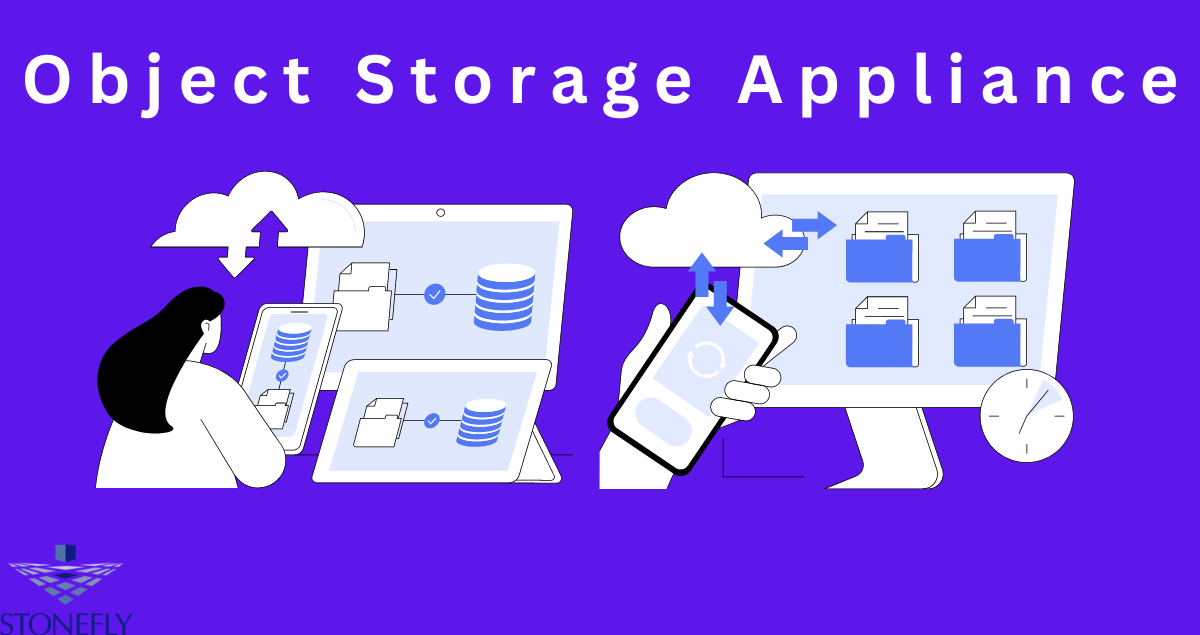Object Storage Appliances: Revolutionizing Data Management
In today’s data-driven era, managing vast amounts of data efficiently is crucial for businesses and organizations. Traditional storage systems often fall short in handling the exponential growth and complexity of data. Enter the Object Storage Appliance (OSA), a game-changing solution designed to address modern data storage challenges.
Object Storage Appliances are specialized hardware devices that store data as objects, rather than traditional block or file systems. Each object consists of the data itself, metadata, and a unique identifier, allowing for highly scalable and efficient data management. This approach is particularly beneficial for unstructured data such as multimedia files, backups, and large datasets.
In this comprehensive guide, we’ll explore the advantages of Object Storage Appliances, key features to look for, real-world use cases, implementation best practices, and future trends in the industry.
Advantages of Object Storage over Traditional File Systems for IT Professionals and Data Scientists
Object storage offers several significant advantages over traditional file and block storage systems, making it an ideal choice for IT professionals and data scientists:
Scalability
One of the most compelling benefits of object storage is its scalability. Unlike traditional file systems that can become cumbersome as data grows, object storage can scale horizontally by adding more nodes to the system. This means you can store petabytes of data without performance degradation.
Data Security and Integrity
Object storage systems provide robust data security features, including encryption, access controls, and immutable data storage, ensuring that your data remains secure and tamper-proof. Metadata associated with each object also helps in maintaining data integrity by enabling checksums and versioning.
Cost Efficiency
Compared to traditional storage systems, object storage can be more cost-effective in the long run. Its ability to use commodity hardware for scaling and efficient use of storage resources reduces overall costs. Additionally, object storage systems often support tiered storage, allowing less frequently accessed data to be stored on cheaper storage media.
Simplified Management
Object storage systems simplify data management by abstracting the underlying hardware and storage infrastructure. This reduces the complexity of managing large datasets and allows IT professionals to focus on higher-level tasks such as data analysis and application development.
Key Features to Look for in an OSA: Scalability, Data Security, and Accessibility
When selecting an Object Storage Appliance for your organization, it’s essential to consider the following key features:
Scalability
Ensure that the OSA can scale horizontally to accommodate growing data needs. Look for solutions that support seamless integration of additional nodes and provide efficient load balancing to maintain performance.
Data Security
Security should be a top priority when choosing an OSA. Check for features such as data encryption, access control mechanisms, and compliance with industry standards. Additionally, consider solutions that offer immutable storage to protect against data tampering and ransomware attacks.
Accessibility
An effective OSA should provide easy and reliable access to your data. Look for features such as multi-protocol support (e.g., S3, NFS, SMB), high availability, and Data replication to ensure your data is always accessible when you need it.
Performance
Performance is critical for data-intensive applications. Evaluate the OSA’s read/write speeds, latency, and throughput to ensure it can handle your workload requirements. Some solutions may offer performance optimization features such as caching and tiered storage.
Integration and Compatibility
Ensure that the OSA integrates seamlessly with your existing infrastructure and supports interoperability with other storage systems, applications, and cloud services. This will facilitate a smooth transition and maximize the value of your investment.
Real-world Use Cases: How Cloud Storage Users are Leveraging OSA
Object Storage Appliances have become indispensable in various industries due to their flexibility and scalability. Here are some real-world use cases:
Media and Entertainment
In the media and entertainment industry, large volumes of high-resolution video and audio files need to be stored and accessed quickly. Object storage provides a scalable and cost-effective solution for managing these extensive libraries, supporting workflows from production to distribution.
Healthcare
Healthcare organizations generate vast amounts of data from medical imaging, electronic health records (EHRs), and genomic research. Object storage helps manage this unstructured data efficiently while ensuring compliance with regulatory requirements and maintaining data integrity.
Financial Services
Financial institutions require secure and scalable storage solutions to manage transaction records, customer data, and analytical datasets. Object storage enables efficient data management, supports regulatory compliance, and provides robust data protection.
Research and Academia
Research institutions and universities often deal with massive datasets from scientific experiments and simulations. Object storage offers the scalability and performance needed to store, access, and analyze this data effectively.
Backup and Disaster Recovery
Object storage is an ideal solution for backup and disaster recovery due to its cost efficiency and durability. Organizations can use object storage to create reliable backups and ensure quick recovery in the event of data loss or system failure.
Implementation and Best Practices: Tips for Maximizing the Benefits of Object Storage Appliances
To fully leverage the benefits of Object Storage Appliances, consider the following implementation best practices:
Assess Your Data Needs
Before implementing an OSA, conduct a thorough assessment of your data storage requirements. Understand the types of data you need to store, access patterns, and growth projections. This will help you choose an OSA that meets your current and future needs.
Plan for Scalability
Design your object storage architecture with scalability in mind. Choose an OSA that supports horizontal scaling and can grow with your data demands. Implement load balancing and data distribution strategies to maintain performance as you scale.
Ensure Data Security
Implement robust security measures to protect your data. Use encryption for data at rest and in transit, enforce access controls, and regularly update security policies. Consider solutions that offer built-in compliance with industry regulations.
Optimize Performance
Monitor and optimize the performance of your OSA. Use caching and tiered storage to improve access speeds for frequently accessed data. Regularly review performance metrics and make adjustments as needed to ensure optimal operation.
Foster Integration
Ensure seamless integration with your existing infrastructure and applications. Use APIs and connectors to enable interoperability with other storage systems and cloud services. This will facilitate data movement and collaboration across different platforms.
Implement Regular Backups
Create a robust backup strategy to protect against data loss. Regularly back up your data to multiple locations and test your recovery procedures to ensure they work as expected. Object storage supports versioning, enabling you to restore previous versions of your data if needed.
The Future of Object Storage: Trends and Innovations to Watch
As technology continues to evolve, several trends and innovations are shaping the future of object storage:
Increased Adoption of AI and Machine Learning
AI and machine learning applications generate and analyze massive datasets, driving demand for scalable and efficient storage solutions. Object storage’s ability to handle unstructured data makes it a natural fit for these applications.
Edge Computing and IoT
The proliferation of edge computing and Internet of Things (IoT) devices is generating vast amounts of data at the network edge. Object storage can help manage and process this data, enabling real-time insights and decision-making.
Hybrid and Multi-cloud Environments
Organizations are increasingly adopting hybrid and multi-cloud strategies to optimize their IT infrastructure. Object storage supports seamless data movement across on-premises and cloud environments, providing flexibility and cost savings.
Enhanced Data Management Capabilities
Future object storage solutions will offer more advanced data management features, such as automated data classification, intelligent tiering, and predictive analytics. These capabilities will further enhance efficiency and reduce operational costs.
Sustainability and Energy Efficiency
As organizations prioritize sustainability, energy-efficient storage solutions will become more critical. Object storage vendors are developing technologies to reduce power consumption and minimize environmental impact.
Conclusion:
Object Storage Appliances offer a powerful solution for managing the ever-growing volumes of unstructured data in today’s digital landscape. With their scalability, data security, cost efficiency, and simplified management, OSAs provide significant advantages over traditional storage systems.
By understanding the key features to look for, exploring real-world use cases, and implementing best practices, you can maximize the benefits of object storage for your organization. As technology continues to evolve, staying informed about emerging trends and innovations will ensure you remain competitive and prepared for the future.
FAQs
Q: What is an Object Storage Appliance?
A: An Object Storage Appliance (OSA) is a hardware device that provides scalable and efficient storage for unstructured data. It uses object-based storage architecture to store data as objects rather than traditional files or blocks.
Q: What are the benefits of using an OSA?
A: Using an OSA offers several advantages, including scalability, durability, cost efficiency, simplified management, and enhanced security. OSAs also support seamless integration with various applications and cloud services.
Q: What industries can benefit from OSA technology?
A: Several industries can benefit from Object Storage Appliances, including healthcare, media and entertainment, financial services, research and academia, and backup and disaster recovery.
Q: How can I choose the right OSA for my organization?
A: To select the best OSA for your organization, consider your data storage needs and growth projections, scalability requirements, security measures, integration capabilities, and backup strategy. You should also research different vendors and their offerings to find the most suitable solution.
Q: What is the future of object storage?
A: The future of object storage looks promising with trends such as increased adoption of AI and machine learning, edge computing and IoT, hybrid and multi-cloud environments, enhanced data management capabilities, and a focus on sustainability and energy efficiency.
Q: How can I stay informed about object storage trends and innovations?
A: To stay updated on the latest developments in object storage, you can follow industry publications, attend conferences and webinars, join online communities, and engage with vendors to learn about their upcoming solutions. So it’s important to continuously explore new resources for information and updates.





